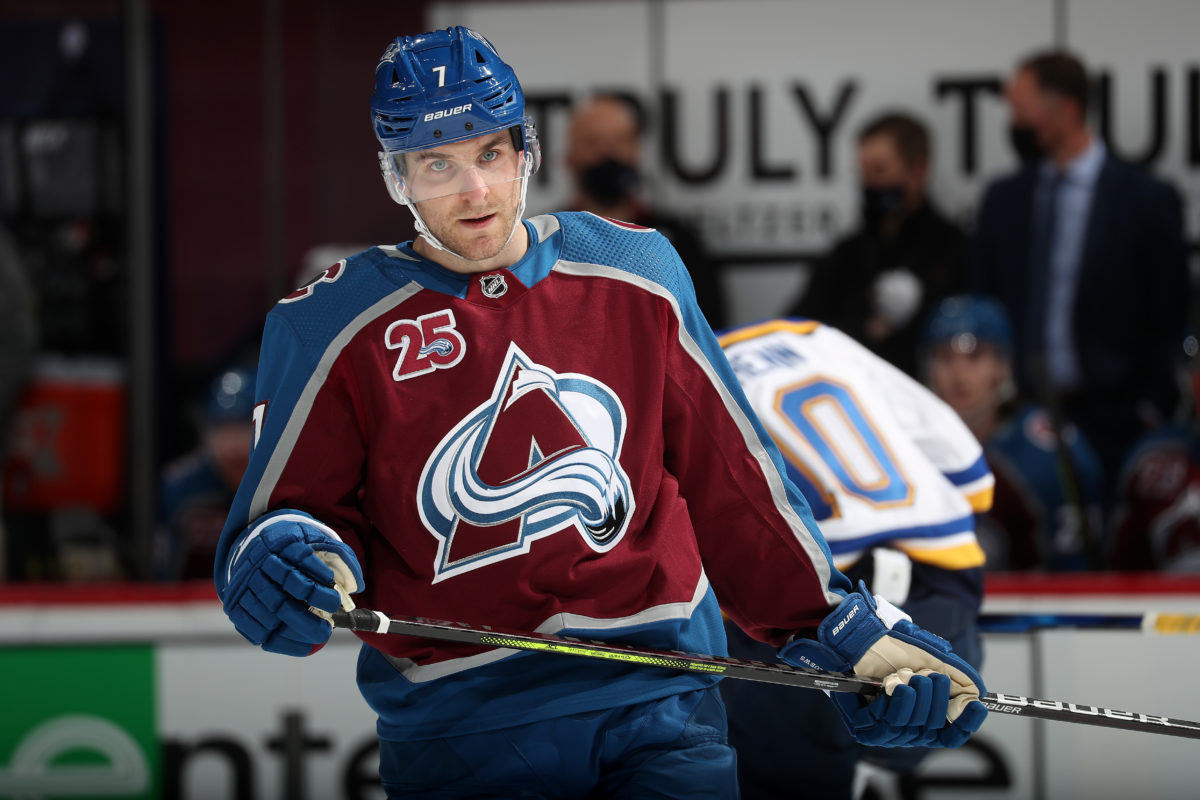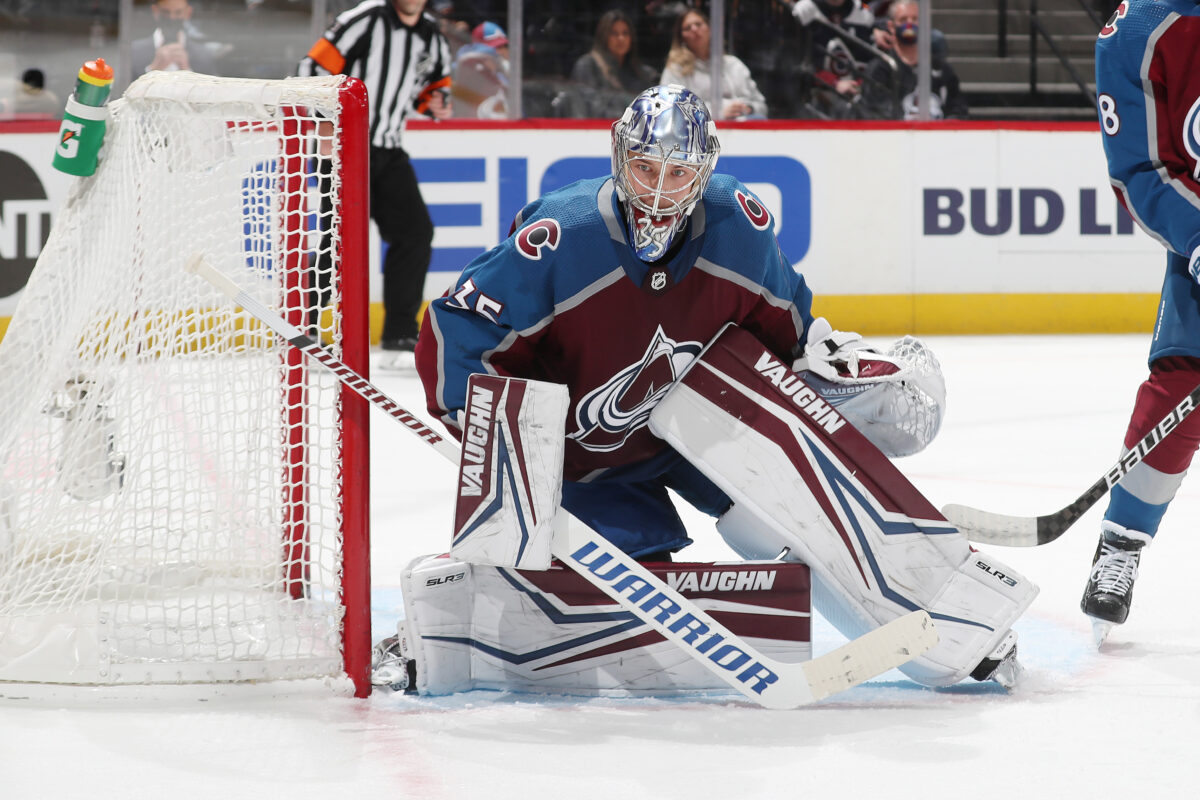By all objective measures, the Colorado Avalanche‘s start to the 2021-22 season is a major disappointment. Fresh off of pipping the Vegas Golden Knights to the 2020-21 Presidents’ Trophy, head coach Jared Bednar’s men were expected to continue dismantling their opposition in a similar manner to last year’s nightly escapades. Instead, a harrowing confluence of factors including injury troubles, underperformance from key offseason acquisitions, and the relative success of their closest competitors in the Western Conference has fans spooked. However, the Avalanche remain atop the NHL’s food chain because of their continued ability to drive play in the face of several significant absences, a renewed commitment to maintaining a robust defensive structure, and the inevitable regression of poor results. Let’s dive in.
Avalanche Have Strong Underlying Numbers Despite Missing Key Players
One of the early storylines of the Avalanche season has been the uncertainty swirling around their lineup on any given night. According to NHL Injury Viz, Colorado has suffered the eighth-highest man-games lost from injury based on the per-game cap hit of their missing players. Leading the charge are key contributors in Nathan MacKinnon, Valeri Nichushkin, and Devon Toews, while Samuel Girard and Gabriel Landeskog have also missed time at points this year. Beyond highlighting the scope of their list of absentees, Colorado’s fill-ins have ensured the team continues to chug along and dominates play, even if the results haven’t manifested on the scoresheet just yet.
A reliable predictor of future success is that a team consistently accounts for a majority of shots, scoring chances, and cumulative chance quality, even if the goals don’t immediately follow. Think of it as the process versus the outcome; you’d expect someone who shoots more to eventually score more goals because of the raw total. In comparison, fewer shots on goals means fewer opportunities to score, and thus capping one’s potential for goals. Luckily, the Avalanche have nailed down the process aspect, raising their ceiling for success.

At five-on-five, Colorado has controlled 54.7 percent of expected goals (xGF%), 56.4 percent of scoring chances, and 59.1 percent of high-danger opportunities. All three values represent top-10 rates in the league, with the latter two both within the NHL’s top-three. Put simply, the Avalanche retain possession of the puck in dangerous areas more often than their opponents, and out-chance them as a result. That’s without the regular presence of several of the team’s aforementioned stars, which has forced depth players to assume a heavier load of the play-driving and play-making responsibilities. It follows that if Colorado’s support system continues to crush easier minutes while the main scoring threats thrive in their usual roles, suddenly the team boasts a similar level of unrivalled depth that they enjoyed last season.
Avalanche’s Elite Defensive Structure Remains
The old (and tired) adage is that an unshakeable commitment to defence wins championships in any sport. Fortunately, the Avalanche can pair their offensive superstars with an impenetrable defensive game plan, making them the most versatile group in the NHL.
That statement may be surprising considering that Colorado’s primary method of defending does not resemble that of traditional thinking. Rather than defending through physical domination or by blocking shots, the Avalanche dominate possession, simply not allowing their opponents to hold the puck long enough to generate any consistent offense. They’re unafraid to recycle the puck back to their blue liners and possess several strong forecheckers, ensuring that they can regroup to get a better look if necessary.
By the numbers, Colorado is a collectively elite defensive unit at five on five. They concede the fewest unblocked shots (xGA/60) and scoring chances against (SCA/60), and rank second and third in high-danger chances allowed (HDCA/60) and expected goals against (xGA/60), respectively. Their extremely mobile defense core frustrates their opponents as through their resistance to even the most voracious of forechecks, and their forwards exemplify a firm commitment to fulfilling their defensive responsibilities. The early struggles in net experienced by Darcy Kuemper have temporarily tarnished Colorado’s image but as I’ll explore in the following section, both the individual Avalanche players and the team as a whole should soon experience a reversal in fortunes.
Avalanche Due for Positive Regression
A crude method for gauging whether a team is getting favourable bounces is to observe their PDO, a statistic which combines a given team’s shooting percentage (SH%) with their save percentage (SV%) at 5v5, the sum of which is multiplied by 10 to obtain a cumulative output. Prevailing thought suggests that the average PDO value is 1000, with outliers on either side of the ledger indicating that a team is either the beneficiary or prisoner of variance.
You May Also Like:
- Colorado Avalanche Won’t Be Contenders This Season
- Colorado Avalanche Lineup Projection for 2024-25
- Avalanche Giving Nikolai Kovalenko a Chance to Prove Himself
- 3 Avalanche Players With the Most to Prove in 2024-25
- Peter “Foppa” Forsberg: A Biography
That’s not to suggest that teams scoring at a prolific clip do not deserve their success per se, but to be wary of assuming their percentages will continue to the same degree across a larger sample of games. Even while accounting for regression to the mean, certain teams and players can hover above or below the average value for reasons beyond simple luck. For example, some franchises employ above-average finishers, while others trot out players hampered by stone hands, both which may contribute to irregular shooting percentages at the individual or team level.
In terms of 5v5 SH%, the Avalanche rank 17th (7.2%), a slight dip from their 8.9 percent conversion (eighth in the NHL) from last season. The thorn in Colorado’s side is their goaltending, which has tanked their PDO through their first eight games. According to MoneyPuck, Colorado’s goaltending cabal has combined to allow the fourth-most goals-above-expected in the NHL, with the team’s 5v5 SV% of .909 grading out as the 28th-best mark this season. Combined, the preseason Cup favourites have slumped to a 981 PDO, 25th in the NHL. In comparison, the Avalanche enjoyed league-average goaltending at 5v5 last season which pushed them to a PDO of 100.5, 11th in the league.

For reference, Logan O’Connor (minus-1.6 goals-below-expected) and Nathan MacKinnon (minus-0.9) are the unluckiest skaters for the Avalanche at the moment. On the other side of the spectrum, Gabriel Landeskog (plus-1.4) and Nazem Kadri (plus-1.2) have scored the most goals above their expected totals, although their strong chance generation should help them avoid extreme drops in their production. It should be noted that although regression is likely, it’s not fully assured. Players can (and do) experience prolonged hot streaks (William Karlsson in 2017-18), or agonizing scoring droughts (Scott Gomez in 2011-12). The gods of luck spare no man.
As such, it’s unwise to expect such a talented crop of skaters backstopped by the historically dependable Kuemper to keep being victimized by the percentages. It’s uncanny how often public perception of a team aligns with their PDO, with unsustainable shooting benders often glorifying groups who are otherwise failing to consistently mount penetrative attacks. The Avalanche, despite grinding through a difficult start, are doing their homework.
Stanley Cup Countdown Begins
Whether or not others agree with my assessment of Colorado’s place in the NHL hierarchy is likely to be a point of contention. What we can agree on is that there is much of the schedule left to comb through, and that it’s foolish to draw decided conclusions from a month’s worth of games. Teams currently enjoying hot starts should fall back to the pack (looking at you Edmonton), and assumed contenders will more closely resemble the versions of themselves that were touted heavily by fans and the media before the season. Underestimate the Avalanche at your own peril, the slumbering giant is waking.
Data courtesy of Evolving Hockey, MoneyPuck, and Natural Stat Trick.